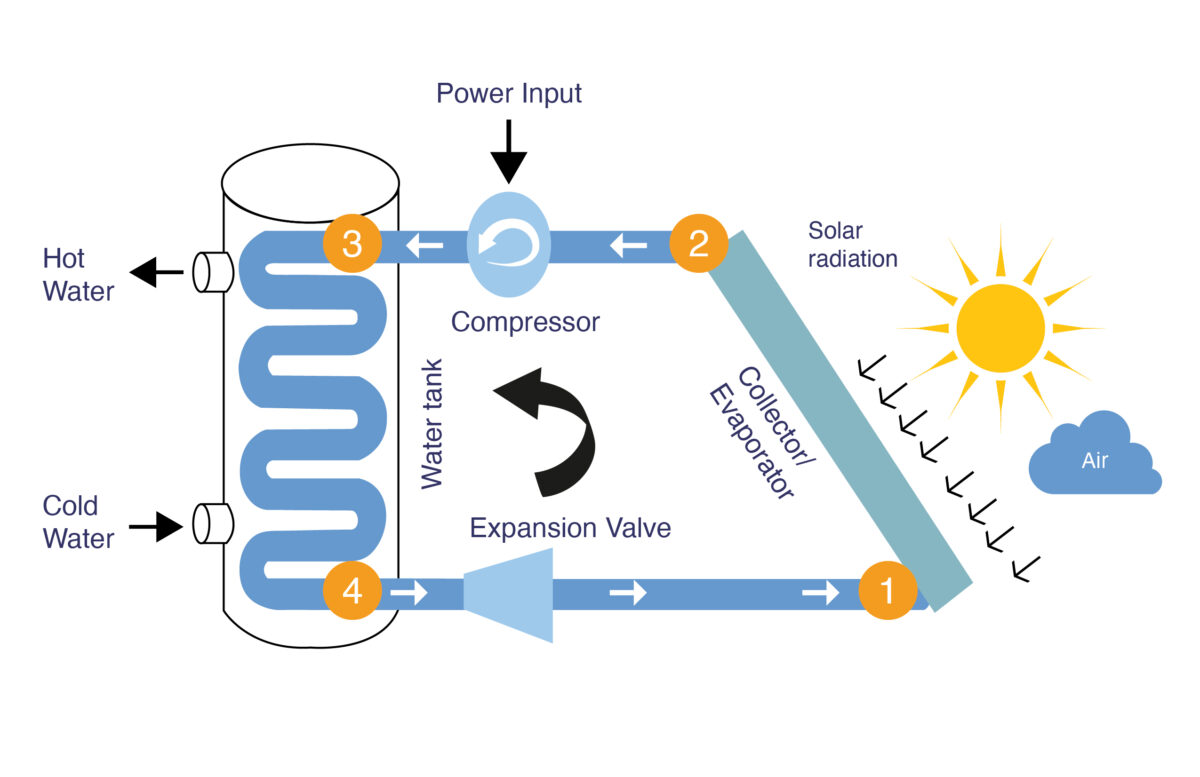An international research team has developed a novel solar-air dual-source heat pump (SAHP) for water heating applications.
The system's innovation lies in using a blower fan that enables forced convection during partial sunshine and diffuse light conditions. Forced convection, like natural convection in regular solar-air dual-source heat pumps, extracts the ambient thermal source to the refrigerant flow.
“This study contributes significantly to advancing SAHP technology, paving the way for more efficient and sustainable water heating solutions in regions with diverse ambient conditions,” added
The Direct Expansion Modified Solar-Air dual-source Heat Pump (SAHP-MDX) includes a rotary hermetic compressor, an expansion valve, and submerged water-cooled condenser coils. The system's novel evaporator, designed to overcome the limitation of natural convection, is constructed by stacking two roll-bonded bare plates with a blower fan in between.
“The ambient air is forced through the dual source bare plate evaporator in SAHP-MDX by two blower fans with individual motor capacities of 35 W,” the scientists said, noting that the system has a solar collector area of 1.6 m2 and a total evaporator area of 3.2 m2. “The rotary hermetic compressor, with rated input power of 910 W and a heating capacity of 3,500 W, compresses the vapor refrigerant (R410A).”
The novel heat pump has three operating modes. One is the Solar-Air source Natural Mode (SANM) with which the system can work throughout the day when solar radiation is higher, enabling the evaporator to gather solar energy and heat from the surrounding air through natural convection.
The Solar-Air source Forced Mode (SAFM) also works throughout the day, but when sunlight is not fully available, the evaporator utilizes forced convection to absorb heat from the surrounding air, as well as solar energy. When insolation is absent during dusk or night hours, the system uses the Air-Source Forced Mode (AFM), as the evaporator absorbs only ambient thermal energy from the air via forced convection.
The novel system was tested in southern India, during five days of winter 2021 and during another five days of summer 2022. It had five water heating cycles daily to try the full array of operational modes. In each cycle it had to heat 300 liters of water from an initial temperature of 31 C to a final one of 50 C.
According to the results, in the SANM mode the system had a coefficient of performance (COP) of 3.62, while the SAFM and AFM achieved 3.37 and 3.05, respectively. The average daily COP of the novel heat pump, throughout the five heating cycles per day was found to be 3.24. The average heating time for the SANM was 163 minutes, 177 minutes for SAFM, and 187 minutes for the AFM.
“Overall, the proposed SAHP-MDX outperforms comparably conventional dual-source heat pumps that exist in practice,” the research group concluded. “It can be used as a feasible substitute for water heating applications in real-world settings with unpredictable weather, ambient air temperature, and solar radiation.”
The scientists described the system in the paper “Optimal utilisation of low-grade solar-air source for heat pump water heating using a dual-source evaporator with forced convection,” which was recently published in International Communications in Heat and Mass Transfer. The researchers come from India's Bannari Amman Institute of Technology, Sri Krishna College of Technology, and Malaysia's Sunway University.
This content is protected by copyright and may not be reused. If you want to cooperate with us and would like to reuse some of our content, please contact: editors@pv-magazine.com.



1 comment
By submitting this form you agree to pv magazine using your data for the purposes of publishing your comment.
Your personal data will only be disclosed or otherwise transmitted to third parties for the purposes of spam filtering or if this is necessary for technical maintenance of the website. Any other transfer to third parties will not take place unless this is justified on the basis of applicable data protection regulations or if pv magazine is legally obliged to do so.
You may revoke this consent at any time with effect for the future, in which case your personal data will be deleted immediately. Otherwise, your data will be deleted if pv magazine has processed your request or the purpose of data storage is fulfilled.
Further information on data privacy can be found in our Data Protection Policy.